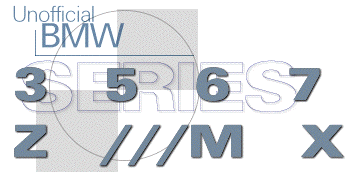|
Ron Stygar Carl Buckland Dale Beuning Forums Help
From: Brett Anderson [mailto:brett_at_koalamotorsport.com] Sent: Friday, January 19, 2001 6:24 PM To: Dorffer, Rich Subject: Re: [E36M3] Alignment Specs & Advice Rich, please pass this on to the E36M3 list. The weights are guides. You have to get the vehicle to the ride height indicated in the specifications. The Hunter machine simply states exactly what BMW does for weight placement, etc, on which models. Hunter doesn't do their own tests, they simply copy the manufacturers specifications and requirements. The locations are guides too. Working on average. BMW tells students at their tech schools to put the weight wherever necessary. Even to open the hood and place the weight over the shock towers if necessary/practical. The ride height spec is usually significantly lower than actual ride height. This is where BMW alignments get confusing. Most people who "know it all", as opposed to those that know...., come up with a line like "well, I want optimum alignment settings on the car with just me in it, because that's how I drive it most of the time...." Fact is, you couldn't ask for a more screwed up alignment, UNLESS, you have significantly changed the suspension characteristics of the car, i.e, solid bushings, severely lowered coil overs, etc. BMW builds thousands of model variants, even the E36 M3 could have possibly come in 500-1000 different variations throughout the world, when you include different body/interior/transmission/wheel options, all intermixed. Each of those variants weighs slightly different, so in order to avoid having to write different alignment specs for any one of 500 possible ride height scenario's, BMW took the heaviest car, subtracted a small amount from it's ride height and designed the alignment specifications for that exact position in the suspension travel. Theory being that if the spec is the same on all cars at that point, it will be at all other points. Now, I'm not arguing the pros and cons of this system, just explaining how BMW does it. Now, as to the weight specs, first of all, they are, as I said above, simply guides. Second, the M3 undoubtedly sits closer to this "ideal" ride height than any other model, because realistically, there weren't that many weight differences between versions, plus it had tighter springs that are effected less by minor weight changes. Therefore, there's no recommendation for a specific weight to be added. The car MUST still come to the specified ride height and even the BMW manual for the M3 states to add weight to bring vehicle to specified ride height. One of the reasons BMW, and other manufacturers, would rather not see their technical information made available to the public is misinterpretation. Jim E, for whatever reason he chose, has left off the final section of the Tech Info sheet he's referring to below. The part where it says: Adjust correct ride level for alignment = specified value +/- 2mm / for E36 M3, E39 M5 and E39 with M sports package specified value +/- 1mm by loading or unloading car. That statement pretty much says it all. Even though they don't tell you what weights to start with in the car, they still expect you to come within 1 mm (for M cars) of the specified ride height. As to techs that tell people "it makes little difference", these are the techs that either don't have ballast handy, or are too lazy to use it. On a current top of the line laser alignment setup like the one I use, you can see alignment readings change just by opening a door, or by moving a seat forward or backward. I challenge any tech that says it doesn't matter to put a car on the rack, print the settings, then load it to correct ride height and print the settings again. On an E36, it can amount to as much as 1 degree of camber in the rear, which in turn, effects toe. Hope this clears some stuff up.
Brett Anderson
> From: nabli_at_attglobal.net [mailto:nabli_at_attglobal.net]
> As a point of reference, BMW Technical Information Bulletin 32 00 Wheel
> "Dorffer, Rich" wrote:
Date: Mon, 22 Jan 2001 08:54:00 -0800 (PST) Rich/Brett, Thanks for the effort and response regarding the proper way to align a BMW In the case where ballast is not available (which is mostly 99% of the alignment places around here in Houston) There must be a compromised setting of the specs so that they compensate for the higher than correct ride height when aligned. I am not in disagreement that camber changes are insignificant, but am I more correct in saying that the importance of knowing that the car is at least properly aligned left to right where the rear thrust angle is = 0 and both front and rear toe angles are equal on both sides (hopefully cancelling out any tendency for the car to pull to one side). Regards
Daniel |

